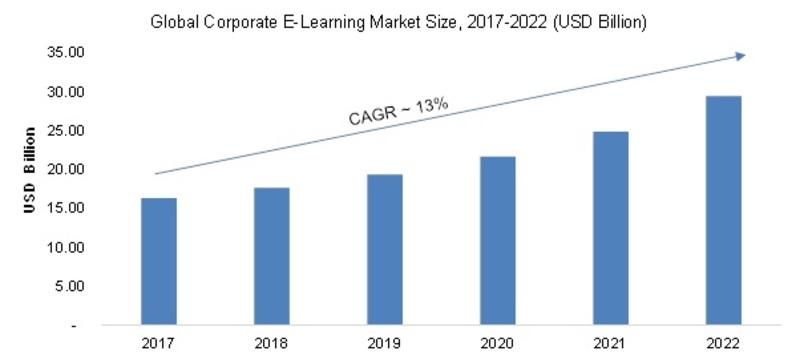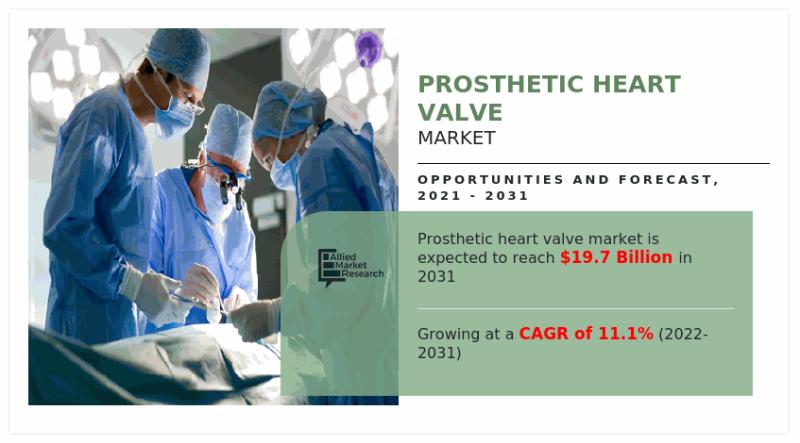Press release
From $6.9 Billion to $19.7 Billion: The Resounding Surge of the Prosthetic Heart Valve Market by 2031
The prosthetic heart valve market has witnessed remarkable growth in recent years, and its trajectory continues to point towards a promising future. In 2021, the market was valued at an impressive $6.9 billion. However, the real story lies in the projections for the upcoming decade. By 2031, the market is anticipated to reach a staggering $19.7 billion, showcasing a robust compound annual growth rate (CAGR) of 11.1% from 2022 to 2031.
The utilization of prosthetic heart valves (PHVs) in patients with valvular incompetence, stenosis, or a combination of both is an essential aspect of modern cardiovascular medicine. Heart valve replacement therapies have witnessed a surge in demand, driven by various factors, including the aging population and the increasing number of individuals diagnosed with heart valve diseases. Here, we delve deeper into the types of PHVs and the technological advancements shaping this field.
𝐃𝐨𝐰𝐧𝐥𝐨𝐚𝐝 𝐑𝐞𝐬𝐞𝐚𝐫𝐜𝐡 𝐑𝐞𝐩𝐨𝐫𝐭 𝐒𝐚𝐦𝐩𝐥𝐞 & 𝐓𝐎𝐂: https://www.alliedmarketresearch.com/request-sample/2176
Key Market Players
1. Edwards Lifesciences
2. Micro Interventional Devices
3. MERIL LIFESCIENCES
4. Medtronic
5. Boston Scientific
6. Abbott
7. LivaNova PLC.
8. Direct Flow medical
9. JenaValve Technology
10. CryoLife
Types of Prosthetic Heart Valves: There are three primary types of prosthetic heart valves:
1. Mechanical Heart Valves: These valves are constructed from durable materials such as metal or carbon, making them exceptionally long-lasting. In ideal conditions, mechanical heart valves can function effectively for up to 30 years. They are highly sought after due to their ability to minimize the risk of blood clot formation on the valve surface, known as thrombogenicity.
2. Bioprosthetic Heart Valves: Bioprosthetic valves are made from biological tissues, often obtained from animal sources or human donors. They offer the advantage of closely mimicking the hemodynamics and function of natural heart valves. While they may not last as long as mechanical valves, they are associated with lower risks of thrombogenicity and are preferred for certain patient populations, especially those who cannot tolerate long-term anticoagulation therapy.
3. Homograft Valves: These valves are derived from human donors, offering excellent hemodynamic performance and low thrombogenicity. However, the availability of homograft valves is limited, and they are primarily used in specific cases.
Technological Advancements: Recent years have seen significant technological advancements in the field of prosthetic heart valves:
1. Durable Tissue Heart Valves: Researchers and manufacturers have been working on enhancing the durability of bioprosthetic heart valves, aiming to extend their lifespan. This development could provide patients with the benefits of both mechanical and bioprosthetic valves.
2. Suture-less Valves: Suture-less valves simplify the surgical implantation process, reducing the time and complexity of the procedure. This innovation is particularly valuable for patients requiring minimally invasive surgeries or those with complex medical conditions.
3. Anti-calcification Technologies: Calcification of heart valves can lead to valve dysfunction over time. Anti-calcification technologies are being integrated into prosthetic heart valves to minimize this issue and extend their longevity.
𝐏𝐫𝐨𝐬𝐭𝐡𝐞𝐭𝐢𝐜 𝐇𝐞𝐚𝐫𝐭 𝐕𝐚𝐥𝐯𝐞 𝐌𝐚𝐫𝐤𝐞𝐭 𝐑𝐞𝐩𝐨𝐫𝐭 𝐇𝐢𝐠𝐡𝐥𝐢𝐠𝐡𝐭𝐬
1. Mechanical Heart Valve:
• Description: Mechanical heart valves are typically made from durable materials like metal or carbon. They consist of mechanical components that open and close to regulate blood flow, mimicking the function of a natural heart valve.
• Advantages: These valves are known for their longevity and durability, often lasting up to 30 years. They have a lower risk of blood clot formation on the valve surface, reducing the need for long-term anticoagulation therapy.
• Considerations: Patients with mechanical heart valves need to take anticoagulant medications to prevent blood clots, which can increase the risk of bleeding complications.
2. Tissue Heart Valve:
• Description: Tissue heart valves, also known as bioprosthetic valves, are constructed from biological tissues. These tissues are typically sourced from animals (porcine or bovine) or human donors.
• Advantages: Bioprosthetic valves closely mimic the hemodynamics and function of natural heart valves. They are associated with a lower risk of thrombogenicity, making them suitable for patients who cannot tolerate long-term anticoagulation.
• Considerations: Bioprosthetic valves have a finite lifespan, generally ranging from 10 to 15 years, and may require replacement.
3. Stented Tissue Heart Valve:
• Description: Stented tissue heart valves are bioprosthetic valves that include a support structure or stent to maintain their shape and facilitate implantation.
• Advantages: The stent provides stability and ease of placement during surgery. These valves offer the benefits of both biological tissue and structural support.
• Considerations: Similar to other bioprosthetic valves, stented tissue valves have a limited lifespan.
4. Stentless Tissue Heart Valve:
• Description: Stentless tissue heart valves are bioprosthetic valves without a supporting stent. They are designed to closely mimic the natural valve's anatomy and function.
• Advantages: Stentless valves offer excellent hemodynamic performance and may have superior durability compared to stented tissue valves.
• Considerations: These valves may be more challenging to implant due to their flexible structure.
5. Transcatheter Heart Valve:
• Description: Transcatheter heart valves are a minimally invasive alternative to traditional open-heart surgery for valve replacement. They are typically deployed through a catheter inserted into a blood vessel.
• Advantages: Transcatheter valves reduce the need for open-heart surgery and have a quicker recovery time. They are suitable for patients at high surgical risk.
• Considerations: Transcatheter procedures may not be suitable for all patients, and long-term durability data are still being studied.
Key Questions Answered in the Intelligent Study
1. What are the key drivers behind the recent surge in demand for prosthetic heart valves?
2. How does the prosthetic heart valve market differ between developed and emerging economies?
3. What role do regulatory agencies play in shaping the prosthetic heart valve market?
4. Can you explain the challenges associated with the long-term durability of bioprosthetic heart valves?
5. How are technological advancements impacting the cost-effectiveness of prosthetic heart valve procedures?
6. What innovative materials are being explored for the development of next-generation mechanical heart valves?
7. What are the implications of the aging population on the prosthetic heart valve market in the coming decade?
8. Are there any groundbreaking research or clinical trials underway for prosthetic heart valve enhancements?
9. How do transcatheter heart valves compare in terms of cost and efficacy to traditional surgical heart valve replacement?
10. What strategies are manufacturers employing to reduce the risk of thrombogenicity in mechanical heart valves?
11. How are artificial intelligence and machine learning being integrated into prosthetic heart valve design and monitoring?
12. What are the economic considerations for healthcare systems when choosing between mechanical and bioprosthetic heart valves?
13. Can you provide insights into the global distribution and availability of homograft valves for heart valve replacement surgeries?
14. What impact has the COVID-19 pandemic had on the prosthetic heart valve market, if any?
15. How are patient preferences and shared decision-making playing a role in selecting the type of prosthetic heart valve?
16. Are there any emerging markets or regions that are expected to experience significant growth in prosthetic heart valve adoption?
17. What are the potential drawbacks or complications associated with minimally invasive transcatheter heart valve procedures?
18. Are there any environmentally sustainable practices being explored in the manufacturing of prosthetic heart valves?
19. How are healthcare disparities affecting access to prosthetic heart valve treatments in different parts of the world?
20. What ethical considerations arise in the use of animal-derived tissues for bioprosthetic heart valves, and are there alternatives being researched?
𝐎𝐫𝐝𝐞𝐫 𝐚 𝐜𝐨𝐩𝐲 𝐨𝐟 𝐭𝐡𝐢𝐬 𝐫𝐞𝐬𝐞𝐚𝐫𝐜𝐡 𝐏𝐫𝐨𝐬𝐭𝐡𝐞𝐭𝐢𝐜 𝐇𝐞𝐚𝐫𝐭 𝐕𝐚𝐥𝐯𝐞 𝐌𝐚𝐫𝐤𝐞𝐭 𝐫𝐞𝐬𝐞𝐚𝐫𝐜𝐡 𝐫𝐞𝐩𝐨𝐫𝐭: https://www.alliedmarketresearch.com/prosthetic-heart-valve-market/purchase-options
𝐀𝐛𝐨𝐮𝐭 𝐔𝐬
Allied Market Research (AMR) is a full-service market research and business-consulting wing of Allied Analytics LLP based in Portland, Oregon. Allied Market Research provides global enterprises as well as medium and small businesses with unmatched quality of "Market Research Reports" and "Business Intelligence Solutions." AMR has a targeted view to provide business insights and consulting to assist its clients to make strategic business decisions and achieve sustainable growth in their respective market domain.
Pawan Kumar, the CEO of Allied Market Research, is leading the organization toward providing high-quality data and insights. We are in professional corporate relations with various companies and this helps us in digging out market data that helps us generate accurate research data tables and confirms utmost accuracy in our market forecasting. Each and every data presented in the reports published by us is extracted through primary interviews with top officials from leading companies of domain concerned. Our secondary data procurement methodology includes deep online and offline research and discussion with knowledgeable professionals and analysts in the industry.
𝐂𝐨𝐧𝐭𝐚𝐜𝐭:
United States
1209 Orange Street,
Corporation Trust Center,
Wilmington, New Castle,
Delaware 19801 USA.
Int'l: +1-503-894-6022
Toll Free: +1-800-792-5285
Fax: +1-800-792-5285
help@alliedmarketresearch.com
The utilization of prosthetic heart valves (PHVs) in patients with valvular incompetence, stenosis, or a combination of both is an essential aspect of modern cardiovascular medicine. Heart valve replacement therapies have witnessed a surge in demand, driven by various factors, including the aging population and the increasing number of individuals diagnosed with heart valve diseases. Here, we delve deeper into the types of PHVs and the technological advancements shaping this field.
𝐃𝐨𝐰𝐧𝐥𝐨𝐚𝐝 𝐑𝐞𝐬𝐞𝐚𝐫𝐜𝐡 𝐑𝐞𝐩𝐨𝐫𝐭 𝐒𝐚𝐦𝐩𝐥𝐞 & 𝐓𝐎𝐂: https://www.alliedmarketresearch.com/request-sample/2176
Key Market Players
1. Edwards Lifesciences
2. Micro Interventional Devices
3. MERIL LIFESCIENCES
4. Medtronic
5. Boston Scientific
6. Abbott
7. LivaNova PLC.
8. Direct Flow medical
9. JenaValve Technology
10. CryoLife
Types of Prosthetic Heart Valves: There are three primary types of prosthetic heart valves:
1. Mechanical Heart Valves: These valves are constructed from durable materials such as metal or carbon, making them exceptionally long-lasting. In ideal conditions, mechanical heart valves can function effectively for up to 30 years. They are highly sought after due to their ability to minimize the risk of blood clot formation on the valve surface, known as thrombogenicity.
2. Bioprosthetic Heart Valves: Bioprosthetic valves are made from biological tissues, often obtained from animal sources or human donors. They offer the advantage of closely mimicking the hemodynamics and function of natural heart valves. While they may not last as long as mechanical valves, they are associated with lower risks of thrombogenicity and are preferred for certain patient populations, especially those who cannot tolerate long-term anticoagulation therapy.
3. Homograft Valves: These valves are derived from human donors, offering excellent hemodynamic performance and low thrombogenicity. However, the availability of homograft valves is limited, and they are primarily used in specific cases.
Technological Advancements: Recent years have seen significant technological advancements in the field of prosthetic heart valves:
1. Durable Tissue Heart Valves: Researchers and manufacturers have been working on enhancing the durability of bioprosthetic heart valves, aiming to extend their lifespan. This development could provide patients with the benefits of both mechanical and bioprosthetic valves.
2. Suture-less Valves: Suture-less valves simplify the surgical implantation process, reducing the time and complexity of the procedure. This innovation is particularly valuable for patients requiring minimally invasive surgeries or those with complex medical conditions.
3. Anti-calcification Technologies: Calcification of heart valves can lead to valve dysfunction over time. Anti-calcification technologies are being integrated into prosthetic heart valves to minimize this issue and extend their longevity.
𝐏𝐫𝐨𝐬𝐭𝐡𝐞𝐭𝐢𝐜 𝐇𝐞𝐚𝐫𝐭 𝐕𝐚𝐥𝐯𝐞 𝐌𝐚𝐫𝐤𝐞𝐭 𝐑𝐞𝐩𝐨𝐫𝐭 𝐇𝐢𝐠𝐡𝐥𝐢𝐠𝐡𝐭𝐬
1. Mechanical Heart Valve:
• Description: Mechanical heart valves are typically made from durable materials like metal or carbon. They consist of mechanical components that open and close to regulate blood flow, mimicking the function of a natural heart valve.
• Advantages: These valves are known for their longevity and durability, often lasting up to 30 years. They have a lower risk of blood clot formation on the valve surface, reducing the need for long-term anticoagulation therapy.
• Considerations: Patients with mechanical heart valves need to take anticoagulant medications to prevent blood clots, which can increase the risk of bleeding complications.
2. Tissue Heart Valve:
• Description: Tissue heart valves, also known as bioprosthetic valves, are constructed from biological tissues. These tissues are typically sourced from animals (porcine or bovine) or human donors.
• Advantages: Bioprosthetic valves closely mimic the hemodynamics and function of natural heart valves. They are associated with a lower risk of thrombogenicity, making them suitable for patients who cannot tolerate long-term anticoagulation.
• Considerations: Bioprosthetic valves have a finite lifespan, generally ranging from 10 to 15 years, and may require replacement.
3. Stented Tissue Heart Valve:
• Description: Stented tissue heart valves are bioprosthetic valves that include a support structure or stent to maintain their shape and facilitate implantation.
• Advantages: The stent provides stability and ease of placement during surgery. These valves offer the benefits of both biological tissue and structural support.
• Considerations: Similar to other bioprosthetic valves, stented tissue valves have a limited lifespan.
4. Stentless Tissue Heart Valve:
• Description: Stentless tissue heart valves are bioprosthetic valves without a supporting stent. They are designed to closely mimic the natural valve's anatomy and function.
• Advantages: Stentless valves offer excellent hemodynamic performance and may have superior durability compared to stented tissue valves.
• Considerations: These valves may be more challenging to implant due to their flexible structure.
5. Transcatheter Heart Valve:
• Description: Transcatheter heart valves are a minimally invasive alternative to traditional open-heart surgery for valve replacement. They are typically deployed through a catheter inserted into a blood vessel.
• Advantages: Transcatheter valves reduce the need for open-heart surgery and have a quicker recovery time. They are suitable for patients at high surgical risk.
• Considerations: Transcatheter procedures may not be suitable for all patients, and long-term durability data are still being studied.
Key Questions Answered in the Intelligent Study
1. What are the key drivers behind the recent surge in demand for prosthetic heart valves?
2. How does the prosthetic heart valve market differ between developed and emerging economies?
3. What role do regulatory agencies play in shaping the prosthetic heart valve market?
4. Can you explain the challenges associated with the long-term durability of bioprosthetic heart valves?
5. How are technological advancements impacting the cost-effectiveness of prosthetic heart valve procedures?
6. What innovative materials are being explored for the development of next-generation mechanical heart valves?
7. What are the implications of the aging population on the prosthetic heart valve market in the coming decade?
8. Are there any groundbreaking research or clinical trials underway for prosthetic heart valve enhancements?
9. How do transcatheter heart valves compare in terms of cost and efficacy to traditional surgical heart valve replacement?
10. What strategies are manufacturers employing to reduce the risk of thrombogenicity in mechanical heart valves?
11. How are artificial intelligence and machine learning being integrated into prosthetic heart valve design and monitoring?
12. What are the economic considerations for healthcare systems when choosing between mechanical and bioprosthetic heart valves?
13. Can you provide insights into the global distribution and availability of homograft valves for heart valve replacement surgeries?
14. What impact has the COVID-19 pandemic had on the prosthetic heart valve market, if any?
15. How are patient preferences and shared decision-making playing a role in selecting the type of prosthetic heart valve?
16. Are there any emerging markets or regions that are expected to experience significant growth in prosthetic heart valve adoption?
17. What are the potential drawbacks or complications associated with minimally invasive transcatheter heart valve procedures?
18. Are there any environmentally sustainable practices being explored in the manufacturing of prosthetic heart valves?
19. How are healthcare disparities affecting access to prosthetic heart valve treatments in different parts of the world?
20. What ethical considerations arise in the use of animal-derived tissues for bioprosthetic heart valves, and are there alternatives being researched?
𝐎𝐫𝐝𝐞𝐫 𝐚 𝐜𝐨𝐩𝐲 𝐨𝐟 𝐭𝐡𝐢𝐬 𝐫𝐞𝐬𝐞𝐚𝐫𝐜𝐡 𝐏𝐫𝐨𝐬𝐭𝐡𝐞𝐭𝐢𝐜 𝐇𝐞𝐚𝐫𝐭 𝐕𝐚𝐥𝐯𝐞 𝐌𝐚𝐫𝐤𝐞𝐭 𝐫𝐞𝐬𝐞𝐚𝐫𝐜𝐡 𝐫𝐞𝐩𝐨𝐫𝐭: https://www.alliedmarketresearch.com/prosthetic-heart-valve-market/purchase-options
𝐀𝐛𝐨𝐮𝐭 𝐔𝐬
Allied Market Research (AMR) is a full-service market research and business-consulting wing of Allied Analytics LLP based in Portland, Oregon. Allied Market Research provides global enterprises as well as medium and small businesses with unmatched quality of "Market Research Reports" and "Business Intelligence Solutions." AMR has a targeted view to provide business insights and consulting to assist its clients to make strategic business decisions and achieve sustainable growth in their respective market domain.
Pawan Kumar, the CEO of Allied Market Research, is leading the organization toward providing high-quality data and insights. We are in professional corporate relations with various companies and this helps us in digging out market data that helps us generate accurate research data tables and confirms utmost accuracy in our market forecasting. Each and every data presented in the reports published by us is extracted through primary interviews with top officials from leading companies of domain concerned. Our secondary data procurement methodology includes deep online and offline research and discussion with knowledgeable professionals and analysts in the industry.
𝐂𝐨𝐧𝐭𝐚𝐜𝐭:
United States
1209 Orange Street,
Corporation Trust Center,
Wilmington, New Castle,
Delaware 19801 USA.
Int'l: +1-503-894-6022
Toll Free: +1-800-792-5285
Fax: +1-800-792-5285
help@alliedmarketresearch.com
Permanent link to this press release:
Copy
Please set a link in the press area of your homepage
to this press release on woodPRI. woodPRI disclaims liability for any content contained in
this release.
Recommend

/newsMicroencapsulation Market Deep Analysis on Key Players - Dow Corning, Encapsys, Syngenta Crop Protection, Evonik Industries, 3M and Bayer
Market Study Report Adds Global Microencapsulation Market Size, Status and Forecast 2024 added to its database. The report provides key statistics on the current state of the industry and other analytical data to understand the market.
Extensive research is required for choosing the appropriate cor...

/newsGermany Airbag Market Size 2023: Global Share, Industry And Report Analysis By 2030 | Hyundai Mobis Co., Ltd. Key Safety Systems, Inc. Robert Bosch GmbH
Germany airbag market is expected to grow at a CAGR of around 6% during the forecast period. Germany Airbag Market research report refers to gathering and analyzing significant market data serve as best medium for various industry players to launch novel product or service. It is vital for key firms...

/newsSecurities Brokerages And Stock Exchanges Market Outlook 2021: Big Things are Happening
A new intelligence report released by HTF MI with title "Global Securities Brokerages And Stock Exchanges Market Survey & Outlook" is designed covering micro level of analysis by Insurers and key business segments, offerings and sales channels. The Global Securities Brokerages And Stock Exchange...

/newsRenewable Chemicals Market Emerging Trends and Competitive Landscape Forecast to 2028
The renewable chemicals market was valued at US$ 80,566.30 million in 2021 and is projected to reach US$ 1,76,750.76 million by 2028 it is expected to grow at a CAGR of 11.9% from 2021 to 2028. The research report focuses on the current market trends, opportunities, future potential of the market, a...

/newsHow Coronavirus is Impacting Cold Brew Coffee, Global Market Volume Analysis, Size, Share and Key Trends 2020-2026
"Market Latest Research Report 2020:
Los Angles United States, February 2020: The Cold Brew Coffee market has been garnering remarkable momentum in the recent years. The steadily escalating demand due to improving purchasing power is projected to bode well for the global market. QY Research's lates...

/newsCorporate E-Learning Market - Global Industry Size, Share, Key Players Analysis that are Infor, SkillSoft Corporation, Adrenna, CERTPOINT Systems and others with Regional Forecast to 2022
Overview:
E-Learning is used to enhance the learning procedures for newer job requirements and to make employees sound about the internal and external changes in the market and respective organizations. This method has created considerable differences in the ways of training and developing employee...
